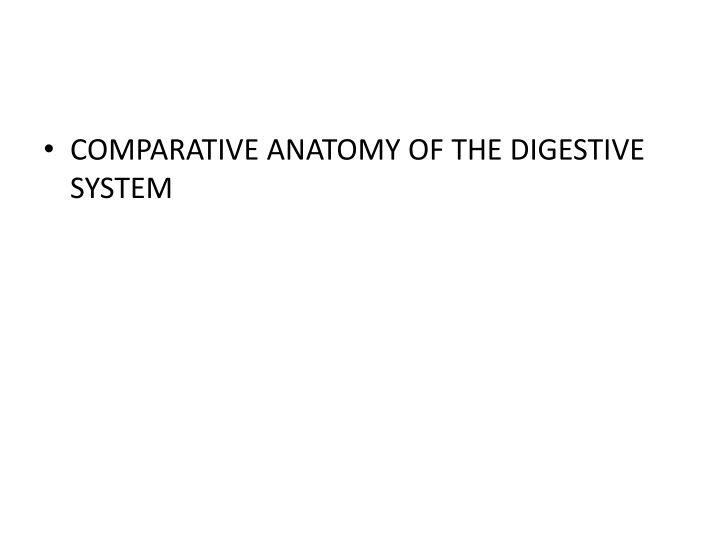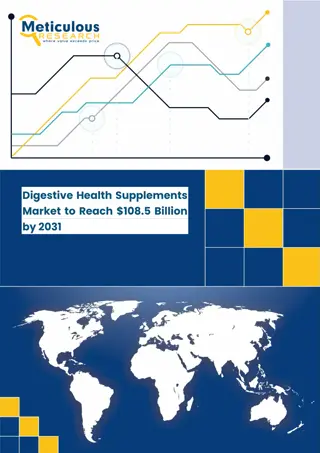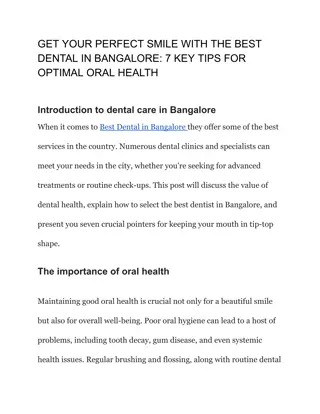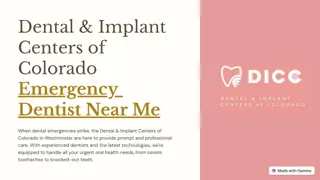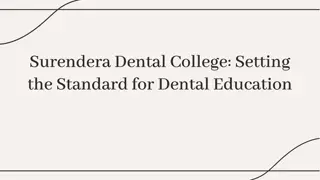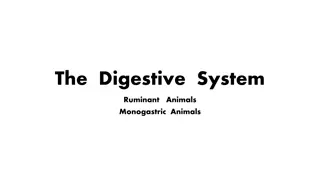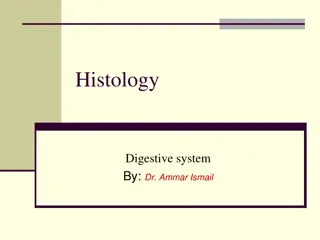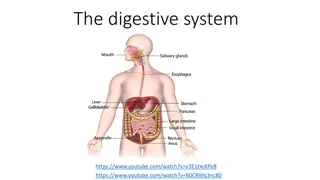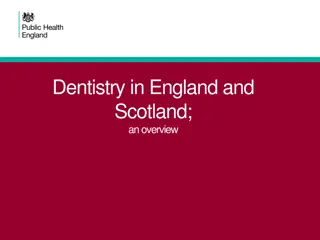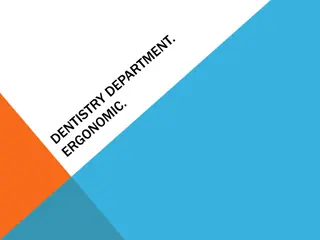Overview of Comparative Anatomy of Digestive Systems and Dental Formulas in Various Animal Species
This content provides a detailed comparison of the digestive systems and dental formulas in different animal species including horses, ruminants, pigs, dogs, cats, and fowls. It delves into the unique characteristics of their tongues, papillae, soft and hard palates, as well as specific features like incisive papillae and nasal palatine ducts. The differences in structure and function highlight the adaptations for each species' dietary and physiological needs.
Download Presentation

Please find below an Image/Link to download the presentation.
The content on the website is provided AS IS for your information and personal use only. It may not be sold, licensed, or shared on other websites without obtaining consent from the author.If you encounter any issues during the download, it is possible that the publisher has removed the file from their server.
You are allowed to download the files provided on this website for personal or commercial use, subject to the condition that they are used lawfully. All files are the property of their respective owners.
The content on the website is provided AS IS for your information and personal use only. It may not be sold, licensed, or shared on other websites without obtaining consent from the author.
E N D
Presentation Transcript
DENTAL FORMULA Horse 2(C3/3, I 1/1, P3-4/3-4, M3/3 ) Ruminant (0/4, 0/0, 3/3, 3/3) Pig (3/3, 1/1, 4/4, 3/3) Dog (3/3, 1/1, 4/4, 2/3) Cat (3/3, 1/1, 3/2, 1/1) The fowl has no teeth
TONGUE Horse spatula shaped Two distinct vallate papillae on cauda of dorsum Bovine Caudal half of dorsum is prominently marked and raised
Papillae on prominence are distinct Filiform and conical papillae are keratinized and caudally directed They give a rough and prehensile surface to the tongue SHEEP Like the Bovine but prominence less raised
PIG Narrow and pointed with a thin apex Long backward pointed papillae on the root DOG Wide, thin and mobile Dorsum marked by median groove Long backward pointing papillae on the root Caudal part of tip has cord of fibrous tissue-Lyssa
SOFT PALATE Horse Long and precludes oral breathing Tonsil is diffuse situated in the sinus, root of tongue and soft palate
HARD PALATE HORSE Divided into two equal portions by the central raphe Palatine ridges or rugae extend the whole length of the palate BOVINE Cranial portion forms the prominent dental pad The rugae extend only 2/3rds of the length of the palate All but the last few are serrated on their free borders
SHEEP Ruggae are not serrated Openings of the naso palatine ducts form a prominent-V on either side of the central incisive papilla PIG Long and narrow Equal in width throughout Both rugae and median raphae are well marked
Incisive paipllae is prominent cranially DOG Widest about the 4thcheek tooth
OESOPHAGUS HORSE Voluntary as far as the base of the heart BOVINE Easily dilatable and voluntary throughout making regurgitation easy PIG Voluntary till last few inches near the cardia DOG Voluntary throughout Constricted ventrally at the origin by mucous glands (isthmus oesophagi).
GLANDULAR STOMACH HORSE Average capacity-3gallons Non glandular portion separated from the glandular by an irregular ridge (margo plicatus) Non glandular left extrimity is called Saccus caecus
PIG Average capacity 2gallons Left extremity has a blind pouch (diverticulum ventriculi) Presence of the torus pyloricus DOG Average capacity-4pints Pear shaped and very distensible
RUMINANT STOMACH Reticulum Rumen Omasum Abomasum A higher proportion of a ruminant s digestive system is stomach
Reticulum characteristics Located next to heart Honeycomb appearance `Catches metal and hardware Pathways `Esophagus `Rumen `Omasum No enzymes secreted i.e. aglandular
Rumen Characteristics Left side of abdomen/ median plane Papillae lining Muscular pillars Fermentation vat `Primarily anaerobic `Some aerobic microbes Not functional at birth Aglandular
Rumen Functions Storage Soaking Physical mixing and breakdown Fermentation `Synthesizes some vitamins `Synthesizes Amino Acids and protein `Breaks down fibrous feeds into VFAs
Rumen Development 48 -100 liters of liquid `Larger in cows on a forage diet `Forage-fed calves have larger rumens 15-21% of mature cow weight is rumen contents
Omasum Manyplies No enzymes from walls Function `Reduce particle size `Absorb some water
Abomasum True stomach that secretes enzymes from walls Glandular stomach like monogastric fundic region `HCL, Mucin `Pepsinogen, Rennin and Lipase
HORSE 6inches from the pylorus Duodenal pouch-diverticulum duodeni Ventral pancreatic and hepatic duscts open in the diverticulum duodeni BOVINE Duodenum commences with a sigmoid flexure Bile duct opens in the ventral part of the flexure
PIG Bile duct opens 2inches from pylorus Single pancreatic duct opens 5inches beyond this point DOG Bile duct and ventral pancreatic duct open 2 inches behind the pylorus Dorsal pancreatic duct opens 2 inches further back
Caecum: comma shaped sac in the horse. Colon has right ventral, left ventral, left dorsal and right dorsal colons
